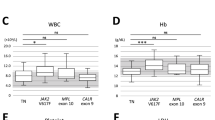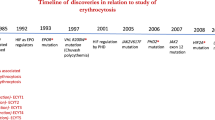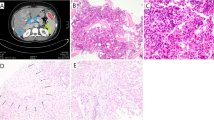Abstract
A 10-year-old girl with persistent erythrocytosis and ruddy complexion was diagnosed with primary familial congenital polycythemia (PFCP) involving a novel heterozygous mutation of c.1220C>A, p.Ser407X in exon 8 of the erythropoietin receptor gene (EPOR). This mutation causes truncation of EPOR, resulting in loss of the cytoplasmic region, which is necessary for negative regulation of erythropoietin signal transmission. Genetic analysis showed that the mutated EPOR was inherited from her mother. Her mother had polycythemia and had undergone venesection several times when she was young, but her polycythemic state appeared to have resolved. Venesection was not needed to maintain Hct levels within normal range. For the case reported here, venesection was also conducted to maintain the blood Hct level below 50%. We observed that after the patient experienced menarche, the volume and frequency of venesection needed to maintain Hct level < 50% were clearly reduced compared with those before menarche. These findings suggest that, in female patients with this type of EPOR mutation, menstruation might reduce blood volume in a manner similar to venesection. Spontaneous remission of erythrocytosis may thus occur after the start of menstrual bleeding.



Similar content being viewed by others
References
Bento C, Percy MJ, Gardie B, Maia TM, Van Wijk R, Perrotta S, et al. Genetic basis of congenital erythrocytosis: mutation of update and online databases. Hum Mutat. 2014;35:15–26.
Peroni E, Bertozzi I, Gherlinzoni F, Stefani PM, Lombardi A, Biagetti G, et al. Two novel missense mutation in EPOR gene causes erythrocytosis in two unrelated patients. Br. J. Haematol. 2016. https://doi.org/10.1111/bjh.14486b.
Pasquier F, Marth C, Verdier F, Grosjean S, Prehu C, Constantinescu SN, et al. New insight into mechanisms of erythropoietin receptor mutations in primary familial and congenital polycythemia. Blood. 2016;128:631.
Arcasoy MO, Karayal AF, Segal HM, Sinning JG, Forget BG. A novel mutation in the erythropoietin receptor gene is associated with familial erythrocytosis. Blood. 2002;99:3066–9.
Sokol L, Luhovy M, Prchal JF, Semenza GL, Prchal JT. Primary familial polycythemia: a frameshift mutation in the erythropoietin receptor gene and increased sensitivity of erythropoietin receptor gene and increased sensitivity of erythroid progenitors to erythropoietin. Blood. 1995;86:15–22.
Matowich SS, Xie X, Klingmuller U, Kere J, Lindlof M, Berglund S, et al. Erythropoietin receptor mutations associated with familial erythropoiesis cause hypersensitivity to erythropoietin in the heterozygous state. Blood. 1999;94:2530–2.
Rives S, Pahl HL, Florensa L, Bellosillo B, Neusuess A, Estella J, et al. Molecular genetic analysis in familial and sporadic congenital primary erythrocytosis. Haematologica. 2007;92:674–7.
Huang LJ, Shen YM, Bulut GB. Advances in understanding the pathogenesis of primary familial and congenital polycythemia. Br J Haematol. 2010;148:844–52.
O’Rourke K, Fairbairn DJ, Jackson KA, Morris KL, Tey SK, Kennedy GA. A novel mutation of the erythropoietin receptor gene associated with primary familial and congenital polycythemia. Int J Hematol. 2011;93:542–4.
Furukawa T, Narita M, Sakaue M, Otsuka T, Kuroha T, Masuko M, et al. Primary familial polycythemia associated with a novel point mutation in the erythropoietin receptor. Br J Haematol. 1997;99:222–7.
Acknowledgement
We thank Ms. Nami Iguchi for her technical assistance in conducting DNA sequence analysis of EPOR.
Author information
Authors and Affiliations
Corresponding author
Ethics declarations
Conflict of interest
The authors declare that they have no conflict of interest.
About this article
Cite this article
Toriumi, N., Kaneda, M., Hatakeyama, N. et al. A case of primary familial congenital polycythemia with a novel EPOR mutation: possible spontaneous remission/alleviation by menstrual bleeding. Int J Hematol 108, 339–343 (2018). https://doi.org/10.1007/s12185-018-2435-1
Received:
Revised:
Accepted:
Published:
Issue Date:
DOI: https://doi.org/10.1007/s12185-018-2435-1




